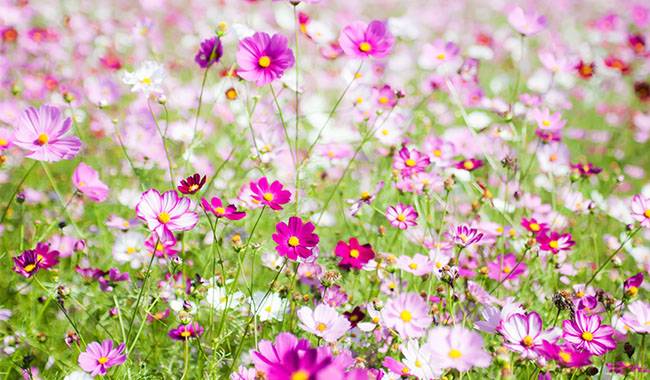
The charming cosmos, cosmos or chamomile, is one of those annuals without which no garden can be imagined. Weightlessly skeletonized and delicate, with a beautiful floral pattern on a solid background of narrow leafy mats, cosmos charms with its cheerful character and simplicity of style.
How to grow cosmos from seed? Actually, the cosmos is easy to grow from seed, even for novice gardeners. After all, it doesn’t even need to be sown in seedlings.
The most popular cosmos are double perennials and their hybrids – large, upright, densely bushy annuals that range in height from 32inch (80cm) to nearly 5foot (1.5m).
The needle-like leaves, somewhat reminiscent of dill or fennel, form translucent, ornate green masses. On a bright green background, feathery flowers flutter on tall, slender pedicels – basket-shaped inflorescences with a series of beautiful, broad-tongued flowers around a neat yellow center.
The petals are very delicate and translucent. cosmea’s color gamut includes all possible shades of the white-pink-red palette, sometimes in two-tone variations.
Although today there is a wide variety of cosmos, allowing for a variety of color palettes and even plant heights, the ease of propagation of these crops has not changed. Without exception, all cosmos are grown from seed (and sulfur, and blood-red, and double flowers).
The plants give abundant self-seeding, and generally, if they appear in the plot, it is good. But it is not difficult to grow cosmea and first planting. For cosmos, you can use the method of seedling sowing, but it is much easier to sow cosmos seeds directly into the soil to the place of cultivation.
After the cosmos is sewn into the soil, it usually starts to bloom in July, and planting seedlings can bloom earlier.
SELF-PICKED SEEDS AND THEIR METHOD OF SELECTION FOR SOWING
The cosmos seeds mature well, even in the central region. Although it continues to flower for quite a long time, it can be collected in large quantities on plants that have already left faded flowers in early autumn.
Cosmos seeds are on sale everywhere. When buying, it is enough to observe the general rules of precautions and selection.
Since cosmos seeds maintain their germination period for more than three years, a single purchase or collection usually lasts a long time.
CONDITIONS REQUIRED FOR COSMOS TO GROW
When planting cosmos seedlings or sowing seeds in the garden, it is very important to choose the right location. cosmos are the most sun-loving annuals, and in the shade, it will be impossible to enjoy these weightless cosmos.
Soil should be fresh, light, friable, and nutrient-rich or at least moderately nutritious. High organic content is welcome, as is a sandy structure. Dense or overly heavy soils can easily be improved by adding compost and sand.
SOWING COSMOS INTO THE SOIL
Unlike some other annuals, for cosmee, sowing into the soil is done immediately in a permanent place in a greenhouse or seedbed. However, the time of sowing is optional. cosmos is sown in spring and can be sown in winter.
The sowing time coincides with the standard sowing time for mid-summer hardy plants. cosmos plants should be sown in early May or in April when the risk of a persistent night freeze has disappeared, but there is no need to wait for the return frost to completely disappear. Under winter, seeds are sown when the soil starts to freeze.
The most common way to sow cosmos is not in rows or furrows, but in shallow holes 12-16inch (30-40 cm) out to create the desired dense planting and minimize thinning work.
In the holes, 2-4 seeds are placed in each hole, and the seedlings are thinned at the seedling stage, leaving only strong seedlings at the optimum distance. When filling cosmos in large areas, seeding can also be done in the usual way.
When sowing in spring, the soil is pre-wetted, and when sowing in winter, no watering is done.
Cosmos seeds need light for germination, so they are simply pressed into the soil and fixed in it, but not covered with soil from above.
When sowing in winter, the place where cosmos seeds are used is covered with snow. Germination appears within 2 weeks in spring in soil or greenhouse.

COSMOS SEEDLING BREEDING
The seedling method is generally used only for rare and new varieties or hybrids with improved flowering. This method is not as good as direct sowing into the ground.
The soil and containers for sowing the cosmos are chosen as the standard. cosmos is best grown in simple substrate seedlings or homemade loose light soil mixed with medium nutrient solution. The pots for sowing should be shallow, but the choice of size depends on personal preference.
Cosmos can be sown individually in small boxes or pots with 2-3 seeds, in large boxes with thinning instead of picking, or with standard sowing and germination. It all depends on the number of seedlings needed and the number of seeds.
Sowing of cosmos seedlings starts in March and continues until the end of April, adjusting the desired flowering time of the plant.
The technique of cosmos seeds is very simple.
- The container is filled with substrate and the soil is lightly moistened with a sprayer. The substrate is not compacted.
- Scatter the seeds on the surface of the soil or place 2-3 seeds at a distance of 3-4inch (8-10cm) (or per cell), slightly pressed or left on the surface. cosmea needs access to light to germinate. Moisten the seeds from above with a sprayer.
- Cover the container with glass or film.
The conditions for cosmos seed germination are not very standard. cosmos germinates poorly at high temperatures and the optimum temperature range is between 59-64°F (15-18°C). Containers with cosmos seeds should be exposed to maximum bright light.
Grow the plants under the same conditions as sown seeds – in cool, bright light.
Germination is done only if you want to keep all the sprouts, to avoid thinning, and not to grow in separate containers. Seedlings can be harvested after a few true leaves appear.
If sowing cosmos in large containers, remove the weakest plants and leave the seedlings with a distance of 3-4inch (7-10 cm) between them. In individual containers, it is also possible to simply pull out the weakest seedlings.
Care of the young universe is standard and boils down to accurate watering and avoiding drought or over-watering. If the seedling stretches, the top of the plant spines, but it is better to organize auxiliary lighting and prevent deformation of the sprouts, because pinching in can adversely affect flowering and delay its start.
Seed hardening of cosmos should be started as early as possible and they should be removed at least for a few hours each day, on a clear day to fresh air.
Only when the threat of night frosts has passed, in May, the seedlings can be planted permanently. The spacing when planting cosmos seedlings is a standard 4-12inch (10-30 cm) for dense arrays and beautifully textured patches. The plants are not afraid of transplanting.
CARING FOR YOUNG COSMOS PLUMS
Cosmos plum is surprisingly drought tolerant, but the plants need to maintain a steady soil moisture level during the early stages of seedling growth. When the universe is establishing a vegetative mass, it is best to water under dry conditions until flowering. During the flowering period, watering should be done only during strong drought and hot weather to maintain abundant flowering and extend the entire flowering period.
When growing cosmos, fertilization is not at all a point that must be taken care of. Adequate mineral fertilizer should be applied to start at the budding stage and repeated several times in summer. During the growing season, the application of fertilizer will cause the accumulation of greenery, which is not conducive to flowering. Excess nitrogen is particularly harmful to the cosmos.
If tall cosmos are sown or planted in windy areas, it is best to take care to install stands and garters as the shrub grows. Due to the light greenery, the plant only needs a plain hanging.
As the first flowers appear, you should start removing faded blooms regularly. Without this simple procedure, the cosmos’ flowering period will be quite shortened and not as lush. For seed collection, selectively leave the largest flowers and remove the rest periodically.
Due to the problem of endurance and resistance with pests and diseases appear in this plant rarely. As a rule, difficulties with decay occur only in unfavorable autumn, and seedlings or shoots are not afraid of diseases.





